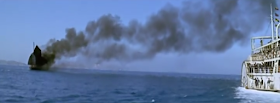A Rank Organization executive, presumably examining Touch of Evil, insisted that his lead actors switch roles. While this may have spared us a reprise of the Wellesian action hero as seen (and worse, heard) in The Lady From Shanghai, his new role gave the great man even greater temptation to indulge his hobby of silly accents. The discrepancy in quality between Welles the director and Welles the actor may not be as vast as in the case of, say, Quentin Tarantino, but when Welles was bad he was horrid, and he's pretty bad here. He reportedly had only himself to blame, since according to Gilbert and Jurgens Welles did his usual thing and rewrote his own dialogue to make his character more comical. This reportedly caused conflicts with Jurgens -- Welles told Peter Bogdanovich that this was the only time he feuded with a fellow actor while performing in a picture -- who wanted to keep the picture a straight drama, regardless of whatever impression he himself made on the audience.
Ferry may well feature Welles's worst-ever performance. His British accent is erratic, veering from a Charles Laughton impersonation to a more plummy approximation of Richard Haydn. If the latter name means nothing to you, think of the professor who makes super carrots that turn Bugs Bunny into a superhero. The voice actor, presumably not Mel Blanc, was imitating Haydn and doing a better job of it than Welles does. The characterization also sprawls all over the place, as Welles can't seem to make up his mind on whether Captain Hart is merely a pompous ass or a complete nincompoop. The film itself, on Welles's initiative or Gilbert's, resolves itself in favor of the captain as a nincompoop to a cartoonish degree -- he even gets blown up in classic cartoon fashion, largely unharmed but left dirty and disheveled -- before treating him with more pathos as the erstwhile Singapore Cecil loses his ship but redeems himself somewhat toward the end. At worst, he gets to wear a plank stuffed down the back of his shirt as a back brace. His recovery and redemption are signified by the removal of this impediment so he may bop a pirate on the bean with it, while Conrad's complete redemption, after leading the rout of the pirates, depends on a final fight with "the dragon." He's fallen in love with the algebra teacher, but as the film closes their union must wait until he cleans himself up fully. His decision not to enter the Dragon nightclub where his recent troubles began is our assurance that a happy ending will follow the actual ending at some point.
At least the location work is nice and Otto Heller's cinematography is often nice. Gilbert could write this nautical adventure off as a tryout not only for his subsequent Sink the Bismarck! and Damn the Defiant but also for a run of James Bond pictures, including a reunion with Jurgens in The Spy Who Loved Me. Fans of Orson Welles have mostly, and fortunately, forgotten this film, which presumably got some more of Don Quixote filmed, if nothing else. There probably were the makings of a better adventure film in the Max Catto novel Gilbert and others adapted, but a proper film required a sharper clash of stronger personalities than Ferry actually delivered. In the end, Welles's grotesque antics are the film's most interesting, if not most entertaining feature.









Oddly, I was unfamiliar with the source novel and thought this film might be based on the story used in the episode of the radio anthology Escape as "Passenger to Bali" by Ellis St. Joseph.
ReplyDeleteSo, now I haven't read either novel... But both sound interesting.